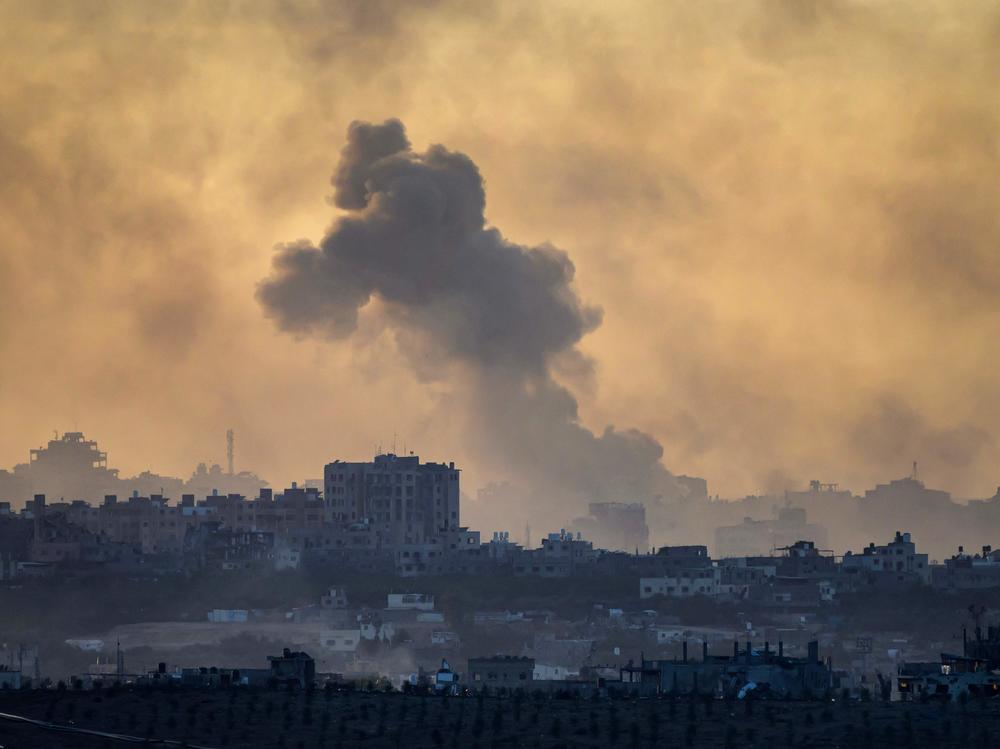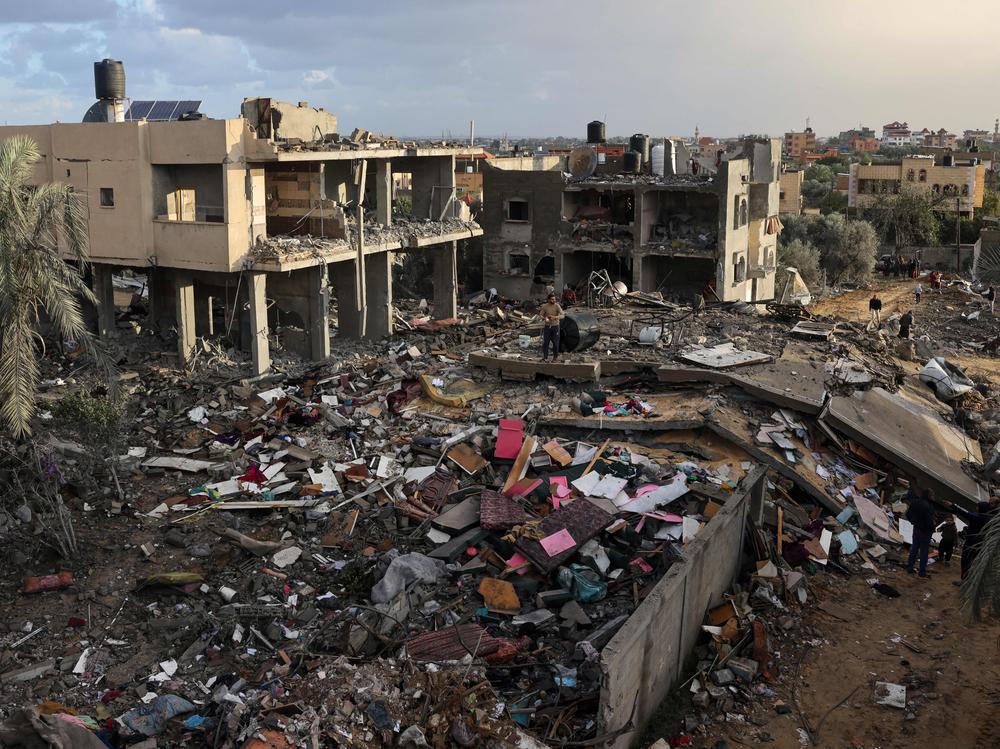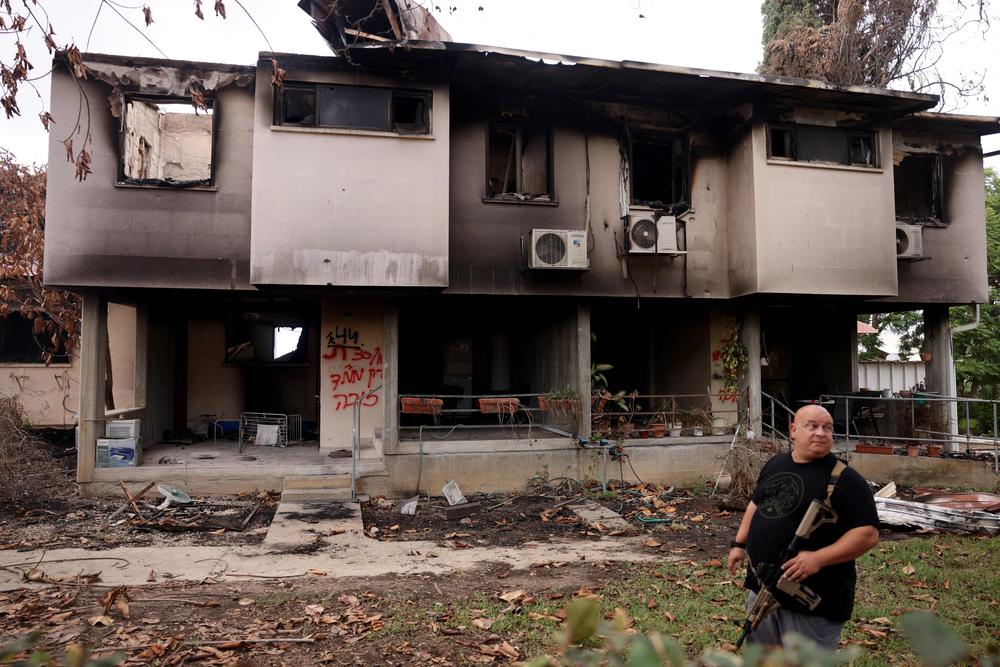Section Branding
Header Content
Civilian deaths are being dismissed as 'crisis actors' in Gaza and Israel
Primary Content
On one side of the split-screen video, a young man lies injured in a hospital bed. A red banner across the top of the frame reads "Yesterday." On the other side, under a green banner reading "Today," a similar-looking man walks through rubble in Gaza.
"I'm now walking in a neighborhood where there were houses. There are no houses anymore," he says.
The post on X, formerly known as Twitter, claims the side-by-side videos show the same person. It accuses him of faking his injuries, only to be "miraculously healed" and walking around just a day later.
But the videos actually show two different people, according to fact checks from multiple media outlets. One is a Palestinian teenager who lost his leg this summer during an Israeli raid in the West Bank. That video was originally posted to TikTok in August.
The other is a Palestinian social media influencer in Gaza who has been documenting the conflict since October.
The conflation of the two individuals is a prime example of a "crisis actor" trope: the false claim that, for propaganda purposes, people are pretending to be victims of tragedies — in this case of Israel's war in Gaza, which Palestinian health officials say has killed more than 14,000 people.
"It is a means by which you blunt those narratives or the reality on the ground," said Moustafa Ayad, executive director for Africa, the Middle East and Asia at the Institute for Strategic Dialogue, a nonprofit that studies extremism. "You discredit them off the bat."
The false accusations have spread on multiple platforms, including X and Facebook, boosted by pro-Israel influencers with large followings. Some of the videos on X carry labels warning they are "presented out of context." But the false claims have still been widely seen, with one video racking up 5 million views.
Crisis actor narratives have become a standard element of the messy information landscape of catastrophe, from the war in Syria to the Russian invasion of Ukraine to mass shootings in the U.S.
Sometimes, the claim is that a real victim never existed. Other times, behind-the-scenes movie footage or images of unrelated events are presented as proof an incident was staged.
But the intent is the same, Ayad said. "It comes out of a defensive posturing: trying to essentially downplay civilian casualties in conflicts of this nature."
And that's why the false claims keep coming. They're a way of deflecting the horrors of war.
"Pallywood" accusations claim civilian casualties in Gaza are staged
Claims that Palestinians are manufacturing injuries and deaths are particularly widespread online, where videos and pictures are often derided as creations of "Pallywood."
That pejorative — a mashup of Palestine and Hollywood — was coined by an American professor in 2005 in the aftermath of disputes over who killed an 11-year-old Palestinian boy five years earlier. In 2013 the Israeli government released a report suggesting the event had been staged and questioning whether the child was shot or killed in the incident. His father, as well as the cameraman who captured the event, reject the report's findings.
Mentions of "Pallywood" have steadily increased across social media platforms since Hamas's Oct. 7 attack, according to fact-checkers at Logically Facts, which tracks online disinformation. Much of the volume is being driven by accounts outside of Israel, Logically Facts found, with the U.S. and India the most common origin for posts that contained geographical data.
Many accusations involve mischaracterized or out-of-context images, like a photo of a Thai child's Halloween costume in 2022 and video from a decade-old protest in Egypt that have been presented as evidence that Palestinians are faking dead bodies. An Israeli government spokesperson posted a clip from a film set, writing "Pallywood gets busted again." (He later deleted the post after being fact-checked.)
One surge in online "Pallywood" references came on Oct. 13, the day Israel's official X account accused Hamas of trying to pass off a doll as a child killed in Gaza. The claim was picked up and echoed by other accounts, including several Israeli embassies.
But the accusation was false. The BBC found and spoke to the family of the child — a four-year-old killed in an Israeli airstrike. Multiple photojournalists captured images of his body, wrapped in a white sheet. The @Israel X account has deleted its post about the child.
The episode showed that "even when the image is real, even when the context is real, people still approach it having so many existing biases that they can dismiss this evidence before their eyes," said Emerson Brooking of the Atlantic Council's Digital Forensic Research Lab during a panel about disinformation in the war.
Israel baselessly accused of engineering "false flag" on Oct. 7
Crisis actor accusations have also been levied at Israelis. Social media posters and even some public figures have questioned whether Hamas really killed 1,200 people in Israel on Oct. 7, despite graphic images and survivors' stories. Some denialists baselessly claim the slaughter was a "false flag" planned by the Israeli government — another common conspiratorial trope, closely related to crisis actor accusations.
When CNN interviewed children whose parents were killed by Hamas, a TikTok user accused the network of "hir[ing] actors and photoshop[ping] grief." That video has been taken down.
A clip from the making of a short film, originally posted online last year, has been used by some to falsely claim Israelis are faking deaths, and by others that it shows Hamas staging a killing.
The flood of crisis actor claims in the current conflict may be a result of the sheer volume of imagery that is available online.
"I don't think we're meant to deal with this level of of traumatizing video," said Mike Caulfield, who studies the spread of viral rumors at the University of Washington's Center for an Informed Public.
Faced with that amount of footage, there's no question it can be hard to sort fact from fiction. Clips from video games and images from other conflicts are being misrepresented as showing Gaza or Israel. Some images have been revealed to be generated by artificial intelligence.
"One of the big themes of this war is just sort of a mass distrust of any images, real or not," said Jack Brewster of NewsGuard, which rates the reliability of online news sources.
But claiming civilian deaths are fake takes skepticism and turns it into justification, ISD's Ayad said.
"One of the toughest parts of a war is believing that your side has been involved in killing civilians," he said. "You will go to great lengths to try to downplay those casualties, because it does have an ability to reframe a lot of the reasons people go to war."
Copyright 2023 NPR. To see more, visit https://www.npr.org.
Correction
A previous version of this story incorrectly attributed data about mentions of "Pallywood" to Logically. It should have been attributed to Logically Facts, which is an independent subsidiary of Logically.



